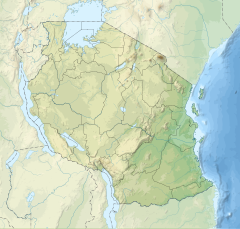| Hyperolius kihangensis | |
|---|---|
| Scientific classification | |
| Domain: | Eukaryota |
| Kingdom: | Animalia |
| Phylum: | Chordata |
| Class: | Amphibia |
| Order: | Anura |
| Family: | Hyperoliidae |
| Genus: | Hyperolius |
| Species: | H. kihangensis
|
| Binomial name | |
| Hyperolius kihangensis Schiøtz and Westergaard, 1999
| |
| Hyperolius kihangensis is only known from the Udzungwa Mountains in Tanzania | |
Hyperolius kihangensis, also known as the Kihanga reed frog[2][3] or volcano reed frog,[3] is a species of frogs in the family Hyperoliidae. It is endemic to the Udzungwa Mountains in south-central Tanzania.[1][2][4][3]
Description
Adult males measure 16–19 mm (0.6–0.7 in) and adult females 23–26 mm (0.9–1.0 in) in snout–vent length.[4][3][5] The body and head are broad and flat. The eyes are large and protruding. The snout is short. Webbing between the toes is reduced.[5] The dorsum is mottled brown and gray with small dark spots. A broad light band runs across the lower back. The heels have a small white dot each. Some individuals have an hourglass pattern on the dorsum. Toes and fingers are yellowish to reddish. The ventral surface is yellow in males and reddish in females.[3] Males have a well-developed vocal sac that is white.[5]
The male advertisement call is a series of quiet clicks[3] – initially, this species was suspected even to be mute.[5]
Habitat and conservation
Hyperolius kihangensis inhabits swamps in dense montane forests at elevations above 1,700 m (5,600 ft).[1] The type series was collected in a dense, swampy forest with shallow, stagnant water, and with the ground was almost completely covered by grass tufts.[5] The eggs are deposited close to the water on leaves.[1]
This species is relatively common within its small range. It is threatened by habitat loss caused by agricultural encroachment and small-scale wood extraction. It is present in the Udzungwa Scarp Forest Reserve, which was expected (as of 2015) to become a nature reserve, improving protection of the habitat.[1]
References
- ^ a b c d e IUCN SSC Amphibian Specialist Group (2016). "Hyperolius kihangensis". IUCN Red List of Threatened Species. 2016: e.T56148A16951518. doi:10.2305/IUCN.UK.2016-1.RLTS.T56148A16951518.en. Retrieved 14 November 2021.
- ^ a b c Frost, Darrel R. (2019). "Hyperolius kihangensis Schiøtz and Westergaard, 1999". Amphibian Species of the World: an Online Reference. Version 6.0. American Museum of Natural History. Retrieved 29 April 2019.
- ^ a b c d e f Zimkus, Breda (2014). "Hyperolius kihangensis Schiøtz and Westergaard in Schiøtz, 1999". African Amphibians. Retrieved 29 April 2019.
- ^ a b "Hyperolius kihangensis". AmphibiaWeb. University of California, Berkeley. 2019. Retrieved 29 April 2019.
- ^ a b c d e Schiøtz, A. & Westergaard, M. M. (2000). "Notes on some Hyperolius (Anura: Hyperoliidae) from Tanzania, with supplementary information on two recently described species" (PDF). Steenstrupia. 25 (1): 1–9.


